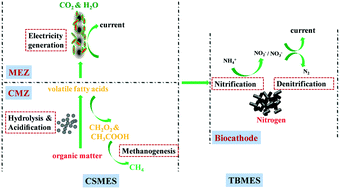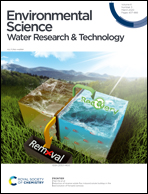Energetically self-sustaining treatment of swine wastewater in a microbial electrochemical technology-centered hybrid system†
Abstract
A two-stage treatment process, consisting of a continuous stirred microbial electrochemical system (CSMES) and a tide-type biocathode microbial electrochemical system (TBMES), was developed for simultaneous electricity generation and swine wastewater treatment. Average maximum power densities of 410 ± 14 mW m−2 and 11.2 W m−3 were obtained by the CSMES and TBMES when raw pretreated swine wastewater was employed as the influent. The combined CSMES–TBMES system realized an overall COD removal of 97.7 ± 4.5% and concomitantly achieved the ammonium nitrogen removal of 85.1 ± 3.3% and total nitrogen (TN) removal of 43.8 ± 2.3%. Each unit of this combined system performed respective functions, with the CSMES responsible for COD removal and the TBMES for subsequent nitrogen removal. A net energy production of 2.509 kW h m−3 was achieved by the CSMES–TBMES system, indicating a positive energy recovery performance for the combined system. Compared with previously reported treatment technologies, this combined system showed great superiority for the treatment of high strength swine wastewater, attributed to the high COD removal rate, efficient ammonium and TN removal, and energy recovery capability.



 Please wait while we load your content...
Please wait while we load your content...